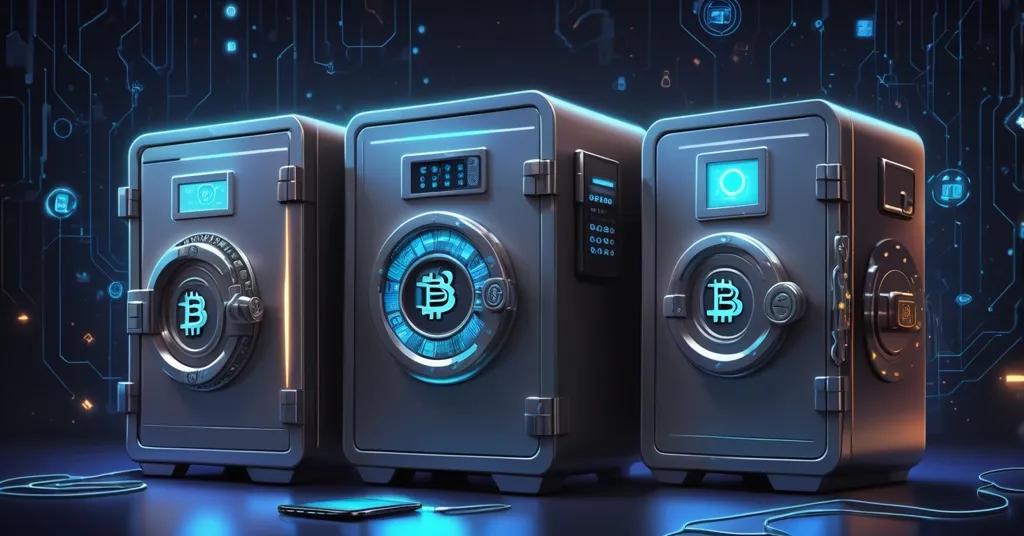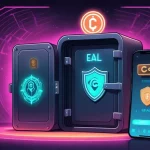D’Cent vs. Trezor: Best Hardware Wallet for Bitcoin and Crypto Security?

D’Cent vs. Trezor: Which Hardware Wallet Should You Trust with Your Crypto?
Choosing a hardware wallet for your Bitcoin and cryptocurrency stash is like picking a vault for your life savings—one prioritizes cutting-edge tech, the other a fortress of proven security. We’re diving deep into D’Cent and Trezor, two titans in the hardware wallet arena, to help you decide which one best protects your digital gold while fitting your lifestyle, whether you’re a mobile-savvy NFT flipper or a privacy-obsessed Bitcoin hodler.
- Mobile Convenience vs. Desktop Security: D’Cent offers a smartphone-friendly design with Bluetooth, while Trezor sticks to a wired, desktop-focused approach for maximum safety.
- Transparency Divide: Trezor’s open-source firmware lets anyone audit its code; D’Cent’s closed-source tech demands trust in the maker.
- Feature Edge: D’Cent excels with NFT management and staking, whereas Trezor boasts vast coin support but lags in modern trends.
Why Hardware Wallets Matter in the Crypto Wild West
Hardware wallets are the cornerstone of cryptocurrency security, keeping your private keys—those critical passwords to your funds—offline and out of reach from hackers who prey on vulnerable exchanges. Unlike hot wallets or exchange accounts, which are perpetually online and ripe for exploits (think Mt. Gox in 2014 or FTX’s collapse in 2022), hardware wallets act like a physical safe, ensuring you truly own your crypto with the mantra “not your keys, not your crypto.” With over 170 hardware wallets on the market, most lacking verifiable transparency according to community audits on forums like Reddit, picking the right one is no small feat as highlighted in user feedback discussions. D’Cent and Trezor stand out, but they serve different needs. D’Cent, a newer contender, pushes a mobile-first, feature-packed experience. Trezor, launched in 2014 by SatoshiLabs as the world’s first hardware wallet, embodies the decentralization ethos with battle-tested security. Let’s dissect their strengths and flaws across key areas to see which aligns with your priorities.
Security Showdown: Trustless Design vs. Modern Tech
Security is the soul of any hardware wallet—without it, your Bitcoin or altcoins are just a hack away from vanishing. Trezor’s flagship strength is its open-source firmware, fully auditable on GitHub, meaning anyone can inspect the code for hidden flaws or backdoors. This “don’t trust, verify” principle, straight from Bitcoin’s roots, is paired with a robust setup: PIN codes, an optional passphrase for hidden wallets (think of it as a secret layer to your vault), and an immutable bootloader—a core system that can’t be tampered with by malicious code as detailed in Trezor’s security transparency analysis. Trezor’s USB connectivity and physical buttons further cut risks by avoiding wireless vulnerabilities. The catch? Setup and firmware updates can be technical, often requiring manual effort, which might daunt less tech-savvy users.
D’Cent counters with a sleek, modern security model. It uses a secure element chip, akin to the tech in credit cards, designed to shield sensitive data like your private keys. Biometric authentication—think fingerprint scanning—adds a user-friendly layer of protection. But here’s the rub: D’Cent’s firmware is closed-source, meaning you’re relying on the manufacturer’s word that it’s secure. For privacy hawks who’ve seen too many “trust us” promises implode in crypto, this is a glaring red flag, especially when contrasted with Trezor as explored in firmware comparison analyses. Plus, its Bluetooth connectivity, while convenient for mobile use, theoretically opens a door to wireless attacks, though no major breaches have been reported. If you’re the type who sleeps with your seed phrase under your pillow, this might keep you up at night.
Stepping back, this is a philosophical clash. Trezor represents a tiny elite of open-source wallets—alongside BitBox and Coldcard—that empower users to verify trust themselves. D’Cent aligns with the majority, asking for faith in proprietary tech. In a post-FTX world where opacity often hides disaster, can you afford to trust blindly? On the flip side, does Trezor’s transparency come at the cost of accessibility for the average user just trying to secure their stack? It’s a trade-off worth chewing on, and you can dig deeper into community perspectives through Reddit discussions on security features.
Coin Support and Use Cases: Breadth vs. Trendy Relevance
For anyone holding more than just Bitcoin, coin support is a dealmaker. Trezor crushes it with compatibility for over 9,000 cryptocurrencies across major blockchains like Bitcoin and Ethereum. It’s a dream for hodlers with sprawling portfolios, covering nearly every corner of the crypto space—except Solana, a popular chain for NFTs and decentralized finance (DeFi). That gap might sting if you’re deep into Solana’s ecosystem. D’Cent supports over 40 blockchains, a smaller but curated list including Bitcoin, Ethereum, Solana, and newer players like Klaytn. Its focus on trending chains positions it well for altcoin enthusiasts and DeFi yield chasers, even if its raw numbers don’t match Trezor’s breadth, as noted in recent comparisons for NFT and staking support.
Beyond storage, D’Cent leans into emerging crypto trends. It offers native NFT viewing and management—perfect for collectors tracking digital art or profile picture (PFP) projects directly on the device. Staking, where you lock up tokens to earn rewards, is also built-in for chains like Cardano, Polkadot, and Cosmos, letting you grow your holdings without third-party risks. Trezor, by contrast, stumbles here. NFT support requires clunky integrations with tools like MetaMask, adding friction and potential security holes. Native staking options are limited too, leaving DeFi-focused users wanting more. If Bitcoin is your fortress, Trezor has you covered; if you’re riding altcoin waves or NFT hype, D’Cent pulls ahead.
Ease of Use: Mobile Magic vs. Desktop Fortress
How a wallet fits into your daily grind matters just as much as its security. D’Cent is crafted for the smartphone era, connecting via Bluetooth to a polished mobile app. Setup takes about 10 minutes, with guided steps that even crypto rookies can follow. The interface is intuitive, prioritizing accessibility—think of it as the iPhone of hardware wallets. Features like token swapping directly in the app add a Swiss Army knife vibe for modern users. Trezor, meanwhile, is rooted in a desktop-first mindset. Its USB connection ties you to a computer, and the Trezor Suite software dominates the experience, with a mobile app that feels like an afterthought. Setup is trickier, with a steeper learning curve and manual updates that can frustrate beginners. It’s a fortress, sure, but one that demands effort to navigate, as outlined in broader hardware wallet comparison resources.
Shifting gears, let’s consider real-world use. If you’re managing your portfolio on the go—say, checking NFTs at a coffee shop—D’Cent’s mobile design shines. But if you’re a Bitcoin maximalist who’d rather air-gap everything (keeping devices completely offline), Trezor’s wired, old-school approach feels safer, even if it’s less sexy. Is mobile convenience worth a potential security trade-off? Or is Trezor’s clunkiness a relic in a world moving to mobile-first tech? Your call depends on how you live your crypto life.
Backup and Recovery: Your Lifeline in a Crisis
Losing access to your crypto due to a lost device or forgotten password is a nightmare scenario. Both wallets use industry-standard seed phrases—a set of random words that can restore your funds on a new device. D’Cent sticks to a 24-word phrase with an optional encrypted backup for added safety, keeping things straightforward. It’s simple, which suits casual users, but lacks deeper customization. Trezor offers more flexibility with 12 or 24-word phrases and an additional passphrase option for hidden wallets. This lets you create multiple secret accounts tied to different passphrases—a slick trick if you’re splitting funds for extra security.
Digging deeper, recovery isn’t just about seed phrases; it’s about resilience. What if your device is stolen or damaged? Trezor’s long history means a robust community of guides and support for recovery scenarios, often shared on forums. D’Cent, being newer, has less of a grassroots knowledge base, though its app-driven design simplifies the process. A word of caution: never store your seed phrase digitally, and consider physical backups like metal plates for fireproofing. One wrong move—like losing your only copy—and no wallet, no matter how fancy, can save you. How paranoid are you about worst-case scenarios? Trezor’s options cater to the ultra-cautious; D’Cent keeps it basic but functional, and you can explore more on secure storage with community insights on wallet security.
Price vs. Value: What’s Your Budget for Peace of Mind?
Cost often tips the scale when features are close. D’Cent’s models range from $119 for the base version to $159 for the biometric upgrade—a reasonable mid-tier price for the mobile perks and NFT support. Trezor spans a broader spectrum, starting at $69 for the bare-bones Model One and climbing to $219 for the premium Model T with a touchscreen. Discounts occasionally sweeten the deal on Trezor’s end, so timing your buy could save a few sats. On raw affordability, Trezor’s entry-level option wins, but D’Cent’s pricing feels justified if you value its modern edge. Are you pinching pennies or investing in a specific feature set? That’s the math to crunch, and for a broader look at top options, check out reviews of top hardware wallets for 2023.
Community Trust and Track Record: Who’s Battle-Tested?
Beyond specs, a wallet’s reputation and longevity speak volumes in a market flooded with shady startups. Trezor’s decade-long run as the first hardware wallet gives it a war chest of trust. Its open-source nature invites community auditing, with code updates often driven by user feedback on platforms like GitHub. Forum chatter on Reddit consistently ranks it among the most reliable for privacy-focused users. D’Cent, as a newer player, lacks that historical heft. While user reviews praise its ease and features, its closed-source model draws skepticism from hardcore crypto OGs, especially regarding Bluetooth risks. No major hacks have hit either, but Trezor’s track record feels like a safer bet for the long haul. Still, D’Cent’s focus on emerging chains suggests it’s adapting to crypto’s future—maybe acceleration trumps tradition here, as you can weigh in detailed comparisons of D’Cent and Trezor?
The Bigger Picture: Convenience or Control?
Zooming out, D’Cent and Trezor embody a core tension in crypto: innovation versus trustless security. D’Cent’s Bluetooth and app-driven design scream effective accelerationism, dragging crypto into everyday mobile life—a win for mainstream adoption. But its closed-source firmware and wireless connectivity raise eyebrows among those burned by industry betrayals. Trezor holds the line for decentralization purists, a reminder of why Bitcoin’s ethos of freedom and privacy matters. Its desktop focus might feel dated, but it’s a bunker for anyone prioritizing zero risk over zero hassle. Let’s not ignore the market noise either—with defunct wallet startups and scammy ads exploiting post-exchange chaos, vetting providers is non-negotiable. Stick to proven names, and don’t fall for hyped promises or fake price predictions. We’ve got zero tolerance for that garbage here.
Key Takeaways and Questions for Crypto Wallet Shoppers
- What makes Trezor a go-to for Bitcoin security?
Its open-source firmware, auditable by anyone on GitHub, ensures no hidden flaws, while USB connectivity cuts wireless risks—ideal for Bitcoin maximalists seeking a trustless setup. - Is D’Cent’s Bluetooth a dealbreaker for safety?
It introduces a theoretical risk of wireless attacks, though no major incidents are documented; it’s a trade-off for mobile ease compared to Trezor’s wired safety. - Which wallet fits mobile users and NFT enthusiasts?
D’Cent’s smartphone app and native NFT management make it the clear choice for on-the-go users and collectors, outshining Trezor’s third-party workarounds. - How does coin support sway your hardware wallet pick?
Trezor’s 9,000+ coin range suits diverse portfolios, while D’Cent’s focus on 40+ trending chains like Solana appeals to altcoin and DeFi players. - Can you rely on a closed-source wallet like D’Cent?
It’s a gamble—you’re trusting the manufacturer in an industry scarred by betrayals; balance that against D’Cent’s convenience and do your homework. - How do backup options differ between Trezor and D’Cent?
Trezor provides flexible 12 or 24-word seed phrases with hidden wallet passphrases, while D’Cent offers a simpler 24-word setup—depth versus ease. - Why does transparency matter for crypto wallets in 2023?
After exchange collapses like FTX, open-source designs like Trezor’s are vital to avoid blind trust, a lesson from past disasters that still stings. - How do I test a wallet’s security before committing funds?
Start small—send a tiny amount of crypto, verify recovery with your seed phrase, and buy only from official sources to dodge tampered devices.
Final Verdict: Which Wallet Wins for You?
Your choice hinges on who you are in the crypto game. If you’re a mobile-first user flipping NFTs or staking altcoins, D’Cent’s app-driven design and modern features are built for you. If you’re a Bitcoin purist or privacy nut who views every wireless signal as a threat, Trezor’s open-source fortress is your bunker. Long-term, Trezor’s decade of grit and community support hint at lasting adaptability, while D’Cent’s eye on emerging chains like Solana positions it for DeFi’s future. Before you buy, audit your needs: security over speed, or features over fortification? Your keys, your responsibility—pick your weapon and secure your stack, because in this space, half-measures are a death sentence.



